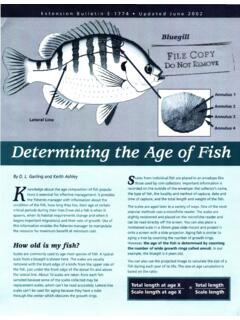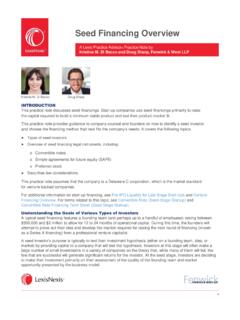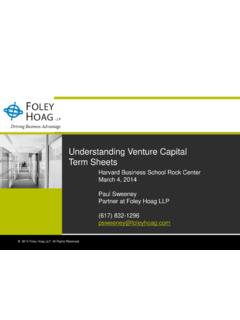Transcription of Business Plan for Startup Business
1 Business Plan for Startup BusinessThe Business plan consists of a narrative and several financial narra-tive template is the body of the Business plan. It contains over 150 questions divided intoseveral through the sections in any order you like, except for the ExecutiveSummary which should be done last. Skip any questions that do not apply to your type you are through writing your first draft, you will have a collection of smallessays on the various topics of the Business you will want to edit them into asmooth flowing real value of doing a Business plan is not having the finished product in hand;rather, the value lies in the process of research and thinking about your Business in a sys-tematic act of planning helps you to think things through thoroughly, study andresearch when you are not sure of the facts, and look at your ideas critically. It takes timenow, but avoids costly, perhaps disastrous, mistakes Business plan is a generic model suitable for all types of businesses.
2 However, youshould modify it to suit your particular circumstances. Before you begin, review the sec-tion entitled Refining the Plan, found at the end of the narrative. It suggests emphasizingcertain areas depending upon your type of Business (manufacturing, retail, service, etc.). Italso has tips for fine tuning your plan to make an effective presentation to investors orbankers. If this is why you are writing your plan, then pay particular attention to your writ-ing will be judged by the quality and appearance of your work as well as your guidance,we have included a document entitled Writing is anexample of an executive summary written in a clear and concise style suitable for this typeof typically takes several weeks to complete a good of that time isspent in research and re-thinking your ideas and assumptions. But then, that is the value ofthe process. So make time to do the job who do, never regret the finally, be sure to keep detailed notes on your sources of information and the assump-tions underlying your financial PlanOWNERSB usiness name:Example Corporation Address:Address Line 1 Address Line 2 City, ST table of of Company and and financial Expenses and the Plan3 Executive summaryWrite this section last!
3 We suggest you make it 2 pages or everything that you would cover in a 5-minute the fundamentals of the proposed Business : what will your product be, who willbe your customers, who are the owners, what do you think the future holds for your busi-ness and your industry? Make it enthusiastic, professional, complete and applying for a loan, state clearly how much you want, precisely how you are going touse it, and how the money will make your Business more profitable, thereby Company DescriptionWhat Business will you be in? What will you do?Mission Statement: Many companies have a brief mission statement, usually in thirty wordsor less, explaining their reason for being and their guiding principles. If you want to draft amission statement,this is a good place to put it in the plan. Followed by:Company goals and objectives: Goals are destinations where you want your Business are progress markers along the way to goal achievement.
4 For example, agoal might be to have a healthy, successful company that is a leader in customer serviceand has a loyal customer following. Objectives might be annual sales targets and some spe-cific measures of customer philosophy:What is important to you in Business ?To whom will you market your products? Your target market? (State it briefly here - youwill do a more thorough explanation in the Marketing section).Describe your industry. Is it a growth industry? What changes do you foresee in your indus-try, short term and long term? How will your company be poised to take advantage ofthem?Your most important company strengths and core competencies:What factors will make the company succeed? What do you think your major competitive strengths will be?What background experience, skills, and strengths do you personally bring to this newventure?Legal form of ownership: Sole Proprietor, Partnership, Corporation, Limited LiabilityCorporation (LLC)?
5 Why have you selected this form? Products and servicesDescribe in depth your products and/or services (technical specifications, drawings, pho-tos, sales brochures, and other bulky items belong in the Appendix).What factors will give you competitive advantages or disadvantages? For example, level ofquality or unique or proprietary are the pricing, fee or leasing structures of your products and/or services?Marketing planNotes on preparation:Market research - Why?No matter how good your product and your service, the venture cannot succeed with-out effective this begins with careful, systematic research. It is very danger-ous to simply assume that you already know about your intended need to domarket research to make sure they are on track. Use the Business planning process as youropportunity to uncover data and question your marketing time will be research - How?There are 2 kinds of market research: primary and researchmeans using published information such as industry profiles, tradejournals, newspapers, magazines, census data, and demographic type of infor-mation is available in public libraries, industry associations, chambers of commerce, ven-dors who sell to your industry, government agencies (Commerce Dept.)
6 And state and localdevelopment agencies), and the SBA Business Information Centers and One Stop with your local library. Most librarians are pleased to guide you through their busi-ness data will be amazed at what is are more online sourcesthan you could possibly good way to start is at the SBA site, ;click the Outside Resources button for a great collection of resource Chamberof Commerce has good information on the local associations and trade publica-tions often have excellent industry specific market researchmeans gathering your own data. For example, you could doyour own traffic count at a proposed location, use the yellow pages to identify competi-tors, and do surveys or focus group interviews to learn about consumer market research can be very costly, but there are many books out that showsmall Business owners how to do effective research by your marketing plan,be as specific as possible; give statistics and numbers marketing plan will be the basis, later on, of the all-important sales projection.
7 The Marketing Plan:EconomicsFacts about your industry:What is the total size of your market? What percent share of the market will you have? (This is important only if you think youwill be a major factor in the market.) Current demand in target marketTrends in target market - growth trends, trends in consumer preferences, and trends inproduct potential and opportunity for a Business of your sizeWhat barriers to entry do you face in entering this market with your new company? Sometypical ones are:High capital costsHigh production costsHigh marketing costsConsumer acceptance/brand recognitionTraining/skillsUnique technology/patentsUnionsShipping costsTariff barriers/quotasAnd of course, how will you overcome the barriers?How could the following affect your company?Change in technologyGovernment regulationsChanging economyChange in your industryProductIn the Products/Services section,you described your products and services as YOU describe them from your CUSTOMER S point of and BenefitsList all your major products or each product/service:Describe the most important is, what will the product do for the customer?
8 What is special about it?Now,for each produce/service, describe its is, what will the product do forthe customer?Note the difference between features and benefits, and think about them. For example, ahouse gives shelter and lasts a long time,is made with certain materials and to a certaindesign;those are its features. Its benefits include pride of ownership, financial security, pro-viding for the family, inclusion in a build features into your product soyou can sell the after-sale services will be given?For example: delivery, warranty, service contracts, support, follow up, or refund your targeted customers, their characteristics, and their geographic locations; , description will be completely different depending on whether you plan to sell toother businesses or directly to consumers. If you sell a consumer product, but sell itthrough a channel of distributors, wholesalers and retailers, then you must carefully ana-lyze both the end consumer and the middlemen businesses to whom you may well have more than one customer group.
9 Identify the most important , for each consumer group, construct what is called a demographic profile:AgeGenderLocationIncome levelSocial class/occupationEducationOther (specific to your industry)Other (specific to your industry)For Business customers, the demographic factors might be:Industry (or portion of an industry)LocationSize of firmQuality/technology/price preferencesOther (specific to your industry)Other (specific to your industry)CompetitionWhat products and companies will compete with you?List your major competitors:Names & addressesWill they compete with you in across the board, or just for certain products, certain cus-tomers, or in certain locations?Will you have important indirect competitors? (For example, video rental stores competewith theaters, though they are different types of Business .)How will your products/services compare with the competition? Use the table called Competitive Analysis, below to compare your company with yourthree most important competitors.
10 In the first column are key competitive factors. Sincethese vary from one industry to another, you may want to customize the list of the cell labeled Me , state how you honestly think you will likely stack up in cus-tomers check whether you think this factor will be a strength of a weaknessfor you. Sometimes it is hard to analyze our own to be very honest yet, get some disinterested strangers to assess can be a real that you cannot be all things to all people. In fact, trying to be so, causes manybusiness failures because it scatters and dilutes your want an honest assess-ment of your firm s strong and weak analyze each major competitor. In a few words, state how you think they the final column, estimate the importance of each competitive factor to the customer. 1= critical; 5 = not very 1: Competitive AnalysisFactorMeStrengthWeaknessCompetit or ACompetitor BCompetitor CImportance to CustomerProductsPriceQualitySelectionSer viceReliabilityStabilityExpertiseCompany ReputationLocationAppearanceSales Method Credit PoliciesAdvertising ImageHaving done the competitive matrix, write a short paragraph stating your competitiveadvantages and that you have systematically analyzed your industry, your product, your customersand the competition,you should have a clear picture or where your company fits into one short paragraph, define your niche, your unique corner of the outline a marketing strategy that is consistent with your will you get the word out to customers?














